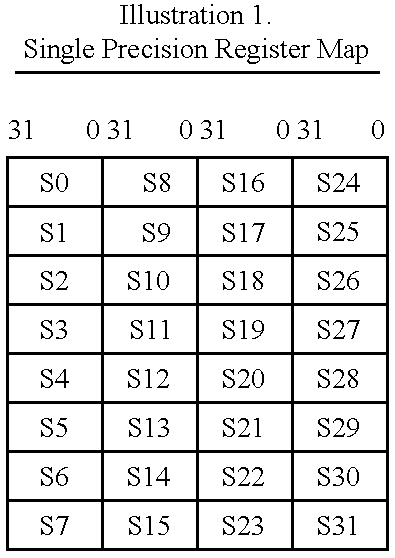Vector register addressing
a vector register and register technology, applied in the field of data processing, can solve the problems of disadvantageously large overhead in cost and complexity, difficult to make global changes to the vector length without having to resort to self-modifying code, and disadvantageously inefficien
- Summary
- Abstract
- Description
- Claims
- Application Information
AI Technical Summary
Benefits of technology
Problems solved by technology
Method used
Image
Examples
Embodiment Construction
FIG. 1 illustrates a data processing system 22 comprising a main processor 24, a floating point unit coprocessor 26, a cache memory 28, a main memory 30 and an input / output system 32. The main processor 24, the cache memory 28, the main memory 30 and the input / output system 32 are linked via a main bus 34. A coprocessor us 36 links the main processor 24 to the floating point unit coprocessor 26.
In operation, the main processor 24 (also referred to as the ARM core) executes a stream of data processing instructions that control data processing operations of a general type including interactions with the cache memory 28, the main memory 30 and the input / output system 32. Embedded within the stream of data processing instructions are coprocessor instructions. The main processor 24 recognises these coprocessor instructions as being of a type that should be executed by an attached coprocessor. Accordingly, the main processor 24 issues these coprocessor instructions on the coprocessor bus ...
PUM
 Login to View More
Login to View More Abstract
Description
Claims
Application Information
 Login to View More
Login to View More - R&D
- Intellectual Property
- Life Sciences
- Materials
- Tech Scout
- Unparalleled Data Quality
- Higher Quality Content
- 60% Fewer Hallucinations
Browse by: Latest US Patents, China's latest patents, Technical Efficacy Thesaurus, Application Domain, Technology Topic, Popular Technical Reports.
© 2025 PatSnap. All rights reserved.Legal|Privacy policy|Modern Slavery Act Transparency Statement|Sitemap|About US| Contact US: help@patsnap.com



